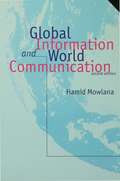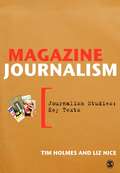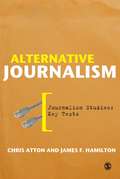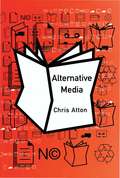- Table View
- List View
Essential Reporting: The NCTJ Guide for Trainee Journalists (PDF)
by Joanne Butcher Jon Smith"If you want a book that instructs you about all the technical skills you need to pass the examinations set by the National Council for the Training of Journalists (NCTJ) and embark on a career in journalism, then this is the book for you. It outlines the basic knowledge required to succeed as a trainee reporter. Shorthand, intros, writing styles, subbing, layout, the way newsrooms work and how to find things out are among the range of skills described. " - Times Higher Education "Precisely what it says on the cover - a down-to-earth essential handbook for anyone embarking on a career in journalism. All you need to know about avoiding newsroom minefields and attracting the editor's attention for the right reasons. If only it had been around in my day!' - Bob Satchwell, Executive Director, Society of Editors This is a book for everyone who wants to be a journalist: a practical guide to all you need to know, learn and do to succeed as a trainee reporter in today's newsroom. Although the world of journalism is changing fast, as technology blurs the boundaries between newspapers, radio, television and web-based media, the reporter's core role remains the same: to recognise news, communicate with people, gather information, and create accurate, balanced and readable stories. Essential Reporting, written by an experienced NCTJ examiner, explains how to do this. Contents include: what makes a good reporter what is news, and how to find it how newsrooms work day-to-day life as a reporter key reporting tasks covering courts and councils successful interviewing writing news stories specialist reporting handling sound, pictures and the web It also contains a wealth of advice, tips and warnings from working journalists, a guide to NCTJ training and examinations, a glossary and a guide to further reading. It will be invaluable to anyone embarking on a career in journalism and is the NCTJ's recommended introductory text for all students on college and university courses preparing them to become successful reporters.
Media Ownership: The Economics and Politics of Convergence and Concentration in the UK and European Media (PDF)
by Gillian DoyleThe digital revolution is transforming media and communications industries worldwide, and media companies are keen to emerge at the forefront of an increasingly transnational and competitive communications marketplace. However, the volume and scale of mergers and alliances involving media players has raised considerable challenges for regulators and state authorities alike. Media Ownership: - Investigates the commercial and strategic advantages of consolidation and cross-media expansion - Examines the socio-political and cultural implications of media concentration - Analyzes how policy makers have responded to media concentration and convergence - Assesses the relationship between media ownership and economic performance - Looks at the balance of power between politicians and media owners This book offers an up-to-date critical overview of the contemporary media environment, as such it will be an essential text for all those with an interest in media economics, media policy, media law and management.
Global Information and World Communication: New Frontiers in International Relations (PDF)
by Hamid MowlanaThe new edition of this major work offers a comprehensive analysis of international communication systems and the global flow of information. Hamid Mowlana places the analysis of global mass media and other forms of communication within a critical overview of international and intercultural relations. Extensively rewritten and revised, Global Information and World Communication deals with the phenomenon of global information flow in all contexts - political, economic, cultural, technological, legal and professional. Mowlana illustrates how different communication strategies and systems have contributed to the creation of powerful interests and have altered the global scene. He takes into account recent events and shows how these have challenged basic assumptions and theories, enabling the debate about communication and world society to embrace broader concepts of world politics, information economy, cultural ecology and international development.
Television Across Europe: A Comparative Introduction (PDF)
by Dr Jan Wieten Peter Dahlgren Professor Graham MurdockCombining institutional textual and audience analysis, this book introduces students to the factors which have shaped television's development in contemporary Europe, and invites them to assess the issues that are at stake in its future. Divided into three parts, the book moves from the European broadcasting environment, through current patterns and trends in programming and programme making, to TV genres and issue-specific broadcasting. Incorporating a range of pedagogical devices: boxes of key facts, activities and notes for further reading, Television across Europe offers an essential introductory guide to television in Western Europe.
Magazine Journalism (PDF)
by Liz Nice Tim Holmes"For those of us who long ago experienced the magazine love-bite and have been battling the prejudice and scant attention shown this beautiful medium ever since, here at last is the book to set the record straight." - Nicholas Brett, Deputy Managing Director, BBC Magazines "At a time when magazines are undergoing active redefinition, this book represents a welcome intervention. It engages with a host of pressing issues in a manner alert to professional priorities while, at the same time, encouraging new ways of thinking about the challenges shaping this fast-moving field. Holmes and Nice are trustworthy guides, taking the reader on what proves to be a fascinating journey." - Stuart Allan, Professor of Journalism, Bournemouth University Magazines are the most successful media format ever to have existed: so begins Magazine Journalism as it traces how magazines arose from their earliest beginnings in 1665 to become the ubiquitous format we know today. This book combats the assumptions among media academics as well as journalists that magazines somehow don't count, and presents a compelling assessment of the development and innovation at the heart of magazine publishing. In magazines we find some of the key debates in journalism, from the genesis of 'marketing to the reader' to feminist history, subcultures and tabloidization. Embedding these questions in a thoroughly historical framework, Holmes and Nice argue for an understanding of magazine journalism as essential in the media landscape. Moving beyond the semiotic and textual analysis so favoured by critics of the past, the authors complete the story with an exploration of the production and consumption of magazines. Drawing on interviews with more than 30 magazine journalists across the industry, what emerges is a story of resilience, innovation and a unique ability to embrace new markets and readerships. Magazine Journalism takes the reader to the heart of key questions in the past, present and future of journalism and is essential reading for students across journalism and the creative industries.
Representing Race: Racisms, Ethnicity and the Media
by Professor Charles Husband Professor John D. Downing"Well-informed, thoughtful and transnational in its perspectives, Downing and Husband's work is likely to become the key text in the field. The book is essential reading for anyone interested in the politics of race and representation." - Professor Daya K. Thussu, University of Westminster The media play a diverse and significant role in the practical expression of racism and in the everyday politics of ethnicity. Written by two veterans of research on media and 'race', this book offers a fresh comparative analyses of the issues and sets out the key agendas for future study. Representing Race - Racisms, Ethnicities and Media: Provides a conceptual framework for understanding the role of the media. Addresses a number of pressing political concerns including 'racial' justice and the drift to the Right. Includes a wide range of examples from Britain, the USA, Europe, and Australia. Analyzes the growth of indigenous people's media. Assesses current strategies for reforming professional media practice in this sphere. Drawing on years of research, this book provides both a major intervention in the debate, as well as a comprehensive introduction to the area. It will be required reading for anyone interested in race, representation and the media.
Alternative Journalism (PDF)
by Dr James F. Hamilton Professor Chris Atton"A provocative, inspiring and challenging intervention in both journalism and media studies.... Alternative Journalism is that rare book that services students as much as scholars. It widens the trajectory of media studies and creates different modes of reading, writing and thinking... It offers an alternative history beyond the tales of great men, great newspapers, great editors and great technologies. It adds value and content to overused and ambiguous words such as "community" and "citizenship" and captures the spark of new information environments." - THE, (Times Higher Education) Alternative Journalism investigates and analyses the diverse forms and genres of journalism that have arisen as challenges to mainstream news coverage. From the radical content of emancipatory media to the dizzying range of citizen journalist blogs and fanzine subcultures, this book charts the historical and cultural practices of this diverse and globalized phenomenon. This exploration goes to the heart of journalism itself, prompting a critical inquiry into the epistemology of news, the professional norms of objectivity, the elite basis of journalism and the hierarchical commerce of news production. In investigating the challenges to media power presented by alternative journalism, Atton addresses not just the issues of politics and empowerment but also the journalism of popular culture and the everyday. The result is essential reading for students of journalism - both mainstream and alternative.
Alternative Media (PDF)
by Professor Chris AttonWhat are `alternative media'? Are they the same as underground, radical or oppositional media? In this book, Chris Atton offers a fresh introduction to alternative media: one which is not limited to `radical' media, but can also account for newer cultural forms such as zines, fanzines, and personal websites. Alternative Media: · Examines how and why people produce and use alternative media - to make meaning, to interpret, and to change the world in which they live · Encompasses a wide range of alternative media and draws on examples from both the United States and United Kingdom · Locates contemporary alternative media in their cultural, historical and political contexts Alternative Media provides a timely corrective to media theorizing which focuses almost exclusively on the output of the media conglomerates. As such it will be an essential purchase for all students and researchers with an interest in the true nature of the contemporary media environment.
Zip Drive and Disk (UEB uncontracted)
by RnibThis page shows images of a Zip disk and a Zip drive. They are separated by a thin vertical line. There is a locator dot shown, which will be at the top left of the page when the image is the right way up. On the left is a top view of a Zip disk and to the right is a drive viewed from the top. Zip disk: This top view of a disk shows a cover at the top of the image. It slides to the left to give access to the magnetic disk inside the casing. There is a label at the bottom for listing the contents of the disk. Zip drive: On the right of the page is an image of the drive seen from the top. At the top of the image is the casing of the drive. Down the page is a clear window with part of a disk visible through it. At the bottom of the page is the remaining portion of the disk with an arrow to the left of it to show the disk being inserted. To the right of the disk are two indicator lights and an eject button. On the right hand edge of the image, at the top and bottom, are two rubber feet to stand the drive on.
Zip Drive and Disk (UEB contracted)
by RnibThis page shows images of a Zip disk and a Zip drive. They are separated by a thin vertical line. There is a locator dot shown, which will be at the top left of the page when the image is the right way up. On the left is a top view of a Zip disk and to the right is a drive viewed from the top. Zip disk: This top view of a disk shows a cover at the top of the image. It slides to the left to give access to the magnetic disk inside the casing. There is a label at the bottom for listing the contents of the disk. Zip drive: On the right of the page is an image of the drive seen from the top. At the top of the image is the casing of the drive. Down the page is a clear window with part of a disk visible through it. At the bottom of the page is the remaining portion of the disk with an arrow to the left of it to show the disk being inserted. To the right of the disk are two indicator lights and an eject button. On the right hand edge of the image, at the top and bottom, are two rubber feet to stand the drive on.
Zip Drive and Disk (large print)
by RnibThis page shows images of a Zip disk and a Zip drive. They are separated by a thin vertical line. There is a locator dot shown, which will be at the top left of the page when the image is the right way up. On the left is a top view of a Zip disk and to the right is a drive viewed from the top. Zip disk: This top view of a disk shows a cover at the top of the image. It slides to the left to give access to the magnetic disk inside the casing. There is a label at the bottom for listing the contents of the disk. Zip drive: On the right of the page is an image of the drive seen from the top. At the top of the image is the casing of the drive. Down the page is a clear window with part of a disk visible through it. At the bottom of the page is the remaining portion of the disk with an arrow to the left of it to show the disk being inserted. To the right of the disk are two indicator lights and an eject button. On the right hand edge of the image, at the top and bottom, are two rubber feet to stand the drive on.
Wide Area Network (tactile)
by RnibThis diagram shows a wide area network. In the centre of the diagram there are 5 nodes connected together. The is a computer connected to a node on the left, and a computer connected to a node on the right.
Virtual Memory (tactile)
by RnibThis diagram shows an example of virtual memory. The parts that are labelled are: page; offset; pages table; +; memory.
Typeface Size and Categories (UEB contracted)
by RnibThis page shows printed characters (letters) in three different type sizes, and two of the main classes of typeface: serif and san-serif (without serifs). There is a locator dot shown, which will be at the top left of the page when the image is the right way up. In the top portion of the page there are three groups of characters increasing in size from 24 point on the left to 72 point on the right. At the bottom left of the page is a capital A with serifs, and on the right another A with no serifs.
Typeface Size and Categories (large print)
by RnibThis page shows printed characters (letters) in three different type sizes, and two of the main classes of typeface: serif and san-serif (without serifs). There is a locator dot shown, which will be at the top left of the page when the image is the right way up. In the top portion of the page there are three groups of characters increasing in size from 24 point on the left to 72 point on the right. At the bottom left of the page is a capital A with serifs, and on the right another A with no serifs.
Typeface Size and Categories (UEB uncontracted)
by RnibThis page shows printed characters (letters) in three different type sizes, and two of the main classes of typeface: serif and san-serif (without serifs). There is a locator dot shown, which will be at the top left of the page when the image is the right way up. In the top portion of the page there are three groups of characters increasing in size from 24 point on the left to 72 point on the right. At the bottom left of the page is a capital A with serifs, and on the right another A with no serifs.
Type Styles (UEB contracted)
by RnibThis page shows printed characters (letters) in two typefaces, Times New Roman and San-serif. Both are presented in regular, italic, bold and bold italic type styles, all in upper and lower case. There is a locator dot shown, which will be at the top left of the page when the image is the right way up. Across the top half of the page is Times New Roman in 72 point size. Across the bottom half of the page is San- serif in 72 point size.
Type Styles (UEB uncontracted)
by RnibThis page shows printed characters (letters) in two typefaces, Times New Roman and San-serif. Both are presented in regular, italic, bold and bold italic type styles, all in upper and lower case. There is a locator dot shown, which will be at the top left of the page when the image is the right way up. Across the top half of the page is Times New Roman in 72 point size. Across the bottom half of the page is San-serif in 72 point size.
Type Styles (large print)
by RnibThis page shows printed characters (letters) in two typefaces, Times New Roman and San-serif. Both are presented in regular, italic, bold and bold italic type styles, all in upper and lower case. There is a locator dot shown, which will be at the top left of the page when the image is the right way up. Across the top half of the page is Times New Roman in 72 point size. Across the bottom half of the page is San- serif in 72 point size.
Transmission Medium (tactile)
by RnibThis diagram shows a high speed medium. 4 routers are linked in an elipse. The line connecting them is labelled as a high-speed backbone. A hub is joined onto the bottom router and has 3 pcs coming from it. The links from pc to hub are labelled ethernet.
Theme Park Project - Schematic and Flowchart (tactile)
by RnibThis diagram shows a schematic and flowchart for a theme park project. Page 1 shows the schematic and page 2 shows the flowchart.
Token Ring (tactile)
by RnibThis diagram shows a token ring network. The arrows between computers represent network connections and direction.
Text Alignment (UEB uncontracted)
by RnibThis page shows four examples of text alignment: left aligned, centred, right aligned and fully justified. There is a locator dot shown, which will be at the top left of the page when the image is the right way up. Left aligned text is shown in the top left quarter of the page; centred in the top right; right aligned at the bottom left and justified at the bottom right. Each example is labelled and has a short description.
Text Alignment (UEB contracted)
by RnibThis page shows four examples of text alignment: left aligned, centred, right aligned and fully justified. There is a locator dot shown, which will be at the top left of the page when the image is the right way up. Left aligned text is shown in the top left quarter of the page; centred in the top right; right aligned at the bottom left and justified at the bottom right. Each example is labelled and has a short description.
Text Alignment (large print)
by RnibThis page shows four examples of text alignment: left aligned, centred, right aligned and fully justified. There is a locator dot shown, which will be at the top left of the page when the image is the right way up. Left aligned text is shown in the top left quarter of the page; centred in the top right; right aligned at the bottom left and justified at the bottom right. Each example is labelled and has a short description.








